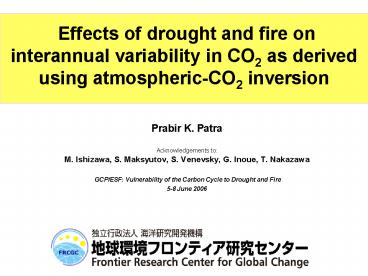Prabir K. Patra - PowerPoint PPT Presentation
Title:
Prabir K. Patra
Description:
M. Ishizawa, S. Maksyutov, S. Venevsky, G. Inoue, T. Nakazawa ... r: inverse model region, s: observation station, t: time. Basic Equations in the Inverse Model: ... – PowerPoint PPT presentation
Number of Views:61
Avg rating:3.0/5.0
Title: Prabir K. Patra
1
Effects of drought and fire on interannual
variability in CO2 as derived using
atmospheric-CO2 inversion
- Prabir K. Patra
- Acknowledgements to
- M. Ishizawa, S. Maksyutov, S. Venevsky, G. Inoue,
T. Nakazawa - GCP/ESF Vulnerability of the Carbon Cycle to
Drought and Fire - 5-8 June 2006
2
Plan of the talk
- Introduction to 64-region TDI framework (based on
CSIRO model Rayner et al.) - Interannual variability and magnitudes of global
and regional fluxes - Effect of draught and fires on terrestrial carbon
cycle - Utility of TDI derived fluxes to understand the
atmospheric-CO2 growth rates
3
64-Regions Inverse Model(using 15 years of
interannually varying NCEP/NCAR winds)
CS cs1 cs2
Inv. Setup Chi2 22 reg 2.15 64 reg
1.11 64IAV 0.99
Patra et al., Global Biogeochem. Cycles., 2005a,b
4
Basic Equations in the Inverse Model
- Forward model simulation of an atmospheric tracer
(e.g. CO2) mathematically is - , where G is a linear
operator representing atmospheric transport (no
chemistry). - Inverse model equations for CO2 fluxes and
uncertainties - r inverse model region, s observation station,
t time
-1
Estimated Flux (r,t)
Atmospheric CO2 Data (s,t)
Estimated Flux Cov. (r,t)
A Priori Flux (r,t)
A Priori Flux Cov. (r,t)
Transport Model Simulation (s,t)
5
Sensitivity of CO2 fluxes to initial conditions
12-month running averages are shown
Patra et al., Global Biogeochem. Cycles., 2005a
6
Comparison with other estimates and the main
controlling factor for CO2 flux interannual
variability
Patra et al., Global Biogeochem. Cycles., 2005a,b
7
Comparison of average ocean fluxes ocean inv.
(Fletcher), atmos. inv. (Patra, Roedenbeck,
TransCom)
Patra et al., Atmos. Chem. Phys., submitted, 2006.
8
Effect of Draught on Regional Land Fluxes
Patra et al., Global Biogeochem. Cycles., 2005b
9
CO2 regional flux anomalies TDI,
Biome-BGC/draught, bottom-up estimates
Patra et al., Global Biogeochem. Cycles., 2005b
10
CO2 regional flux anomalies TDI,
Biome-BGC/draught, bottom-up estimatesand
fire emissions
11
Regional Flux Anomaly (1994-2004) EuropeCiais
et al., 2005 0.5 Pg-C for 2003
12
Studying CO2 Growth Rate at Mauna Loa, Hawaii
using TDI model fluxes
Patra et al., Tellus, 2005c.
13
Simple empirical relations for atmospheric-CO2
growth rate prediction
Sources/Increase Rates 1971- 1972 1986-1987 2001-2002
El Nino (Gt-C) 4.0 2.3 2.1
Boreal Fire (Gt-C) 0.0 0.5 0.28
CO2 Gr. Rate (estimated) (ppm/yr) 1.9 1.6 1.3
CO2 Gr. Rate (observed) (ppm/yr) 1.8 1.5 1.3
this flux is confined to NH only
Green diamond van der Werf et al. Vertical bar
Kasischke and Bruhwiler
Patra et al., Tellus, 2005c.
14
Simulation of CO2 Growth Rates and seasonal
cycles using TDI fluxes
Patra et al., ACP, 2006.
15
Conclusions
- CO2 flux determination primarily depend on
- Selection of observational networks
- Forward transport modelling (less on techniques)
- The flux variability over land and ocean are
linked fundamentally to the climate, e.g., ENSO,
NAO, PDO - This enables us to establish a CO2 growth rate
prediction model based on empirical relations. - Interannual variability in terrestrial ecosystem
fluxes, and thus atmospheric CO2 are primarily
controlled by draught and fire































